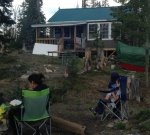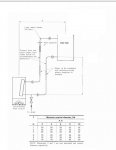Hi All, Hoping you can help with getting me started on treating the water in a redneck hot tub which I'm currently building for the family cabin. The core components being a plastic 300 gallon livestock tank and a wood fired water heater/boiler made of steel and copper. I've done some researching, but cannot find information about my particular scenario.
It's a remote and rustic cabin in the woods. No services, no power for pumps, not accessible by 4x4, etc. Tub will be used for up to 5 days at a time and will be completely drained between uses. Water will be pumped from the lake to fill via a gasoline powered water pump. Lake water quality is pretty good, it's a mountain lake and a source of drinking water for nearby town, but yeah - it's untreated water.
Initially, I wasn't planning to treat the water at all. But I've since come to the conclusion that I'll need to do something.
What I've come up with so far is to do a chlorine "shock treatment" when I 1st fill the tub and allow the chlorine to evaporate off while the tub comes up to temp (expected to take 8hrs or so). Then just use one of those floating bromine dispensers to maintain. Would that be a reasonable approach to get me by for up to 5 days? In most cases it'd only need to last 3 days.
Thanks!
It's a remote and rustic cabin in the woods. No services, no power for pumps, not accessible by 4x4, etc. Tub will be used for up to 5 days at a time and will be completely drained between uses. Water will be pumped from the lake to fill via a gasoline powered water pump. Lake water quality is pretty good, it's a mountain lake and a source of drinking water for nearby town, but yeah - it's untreated water.
Initially, I wasn't planning to treat the water at all. But I've since come to the conclusion that I'll need to do something.
What I've come up with so far is to do a chlorine "shock treatment" when I 1st fill the tub and allow the chlorine to evaporate off while the tub comes up to temp (expected to take 8hrs or so). Then just use one of those floating bromine dispensers to maintain. Would that be a reasonable approach to get me by for up to 5 days? In most cases it'd only need to last 3 days.
Thanks!



